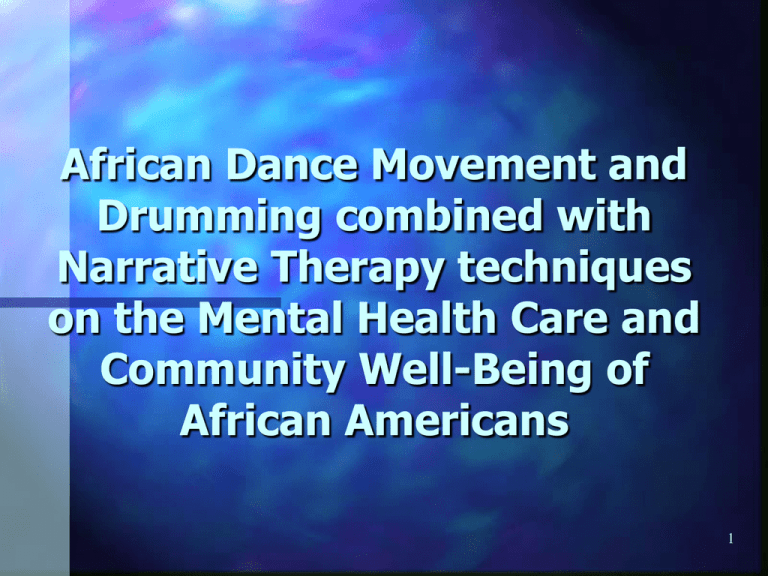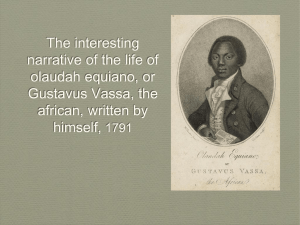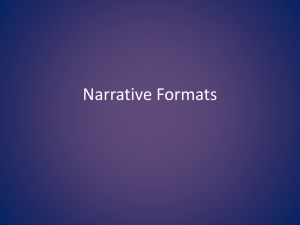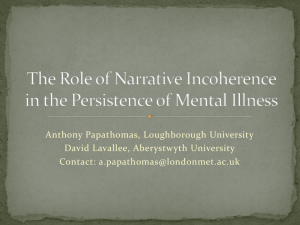African Dance Movement and Drum Combined with Narrative
advertisement

African Dance Movement and Drumming combined with Narrative Therapy techniques on the Mental Health Care and Community Well-Being of African Americans 1 African to African American Africans brought from various slave ports such as Goree island in Senegal primarily to the Americas (North, Mexico, Central and South) and the Caribbean. Left behind rituals, routines and practices that kept community together. 2 Africa – Forced Disconnect from the Motherland to the rest of the world Africans brought to North America, the Caribbean, Mexico, Central America and South America. i.e. Afro-Mexican general Vicente Guerrero 3 Establishing life in the Americas Forced to reestablished life and norms during and after slavery. “remembered” ways to hold on to history. For example, all slaves that were able to – attempted to recreate memories in the form of dances, rhythms etc.. That matched life events such as Rites of Passage. Purpose is to ameliorate the negative effects of oppression 4 Africans who became slaves adapted: immortalized and transformed indigenous practices into various enduring art forms today - Strengths Dios de los Muertos – Halloween Carnival – Lent Capoeira – Brazilian slaves from the Bantu people in Angola hid this form of Martial Arts by making it look like a dance. Banned by slave-owners The Blues & Gospel Spoon & Hand Rhythms (African Americans) Samba, rumba, salsa, tap, dance Calypso (Jamaica, Trinidad ) Call & Response 5 Historical review Europe – Media, Research journals, Art – all castigated Africans with negative images and “scientific” evidence of race based inferiority. Slave Trade & Slavery. Emancipation officially but many people in rural communities not informed and kept as slaves. Birth of Prison industry as a form of maintaining slavery – Wardens and prison owners incarcerating local men and women to farm lands. Minstrel period – Powerful media images that live with us today. Jim Crow & Civil Rights Post-Obama – where we are today 6 Impact to the African American Community? The collective experience: created a deeply entrenched set of internalized self-hate that – while on a continuum - remains today. Colorism 7 Music & Dance Therapy Music and Dance therapy is used in psychiatric hospitals, schools, prisons and drug and alcohol treatment centers, and assisted living environments. 8 Music Therapy Music has been found to be helpful with many psychiatric disorders. It has been used as complementary therapy in mental health with the disorders of Autism (Walworth, 2007), Selective Mutism (Amir, 2005), Schizophrenia (Ulrich, 2007), Depression, (Morgan, 2008, Lin, 2011, Werner, 2009), Stress, (Labbe, 2007) Dementia, (Guetin, 2009, Takahashi, 2006, Ziv, 2007), Anxiety & Depression (Choi, 2010; Hernandez-Ruiz, 2005), Insomnia (Bloch, 2010; Ziv, 2008), and Substance Use (Aldridge, 2010; Abdollahnejad, 2006, Horesh, 2003). Further, music has even been used to address pain behaviors in patients with mild to moderate cognitive impairment (Shega, 2008). 9 Dance/Movement Therapy “Focused on movement behavior as it emerges in the therapeutic relationship. Expressive, communicative, and adaptive behaviors are all considered for group and individual treatment. Body movement, as the core component of dance, simultaneously provides the means of assessment and the mode of intervention for dance/movement therapy.” American Dance Therapy Association 10 Narrative Therapy Narrative Psychotherapy assumes that the past can be changed by creating new narratives or stories of an individual’s past. Narrative therapists believe that we have the power within ourselves to create these stories and turn them into more preferable outcomes (Prochaska & Norcross, 2007). Narrative Theorists believes that therapists should not be the ones to tell clients who they are. In turn, it should be the clients who are free to tell us who they are and who they want to be (Prochaska & Norcross, 2007). Gehart and Tuttle (2003) explain that people use stories to explain their lives and bring meaning to them. The primary goal is to reform the narrative that is saturated with problems into a narrative that is more preferable to the client. 11 Narrative Therapy Reality is socially constructed. The world exists of multiple viewpoints and realities. Our Reality gain strength and staying power when we give them meaning with our language. The goal of Narrative therapy is for the individual or family to “re-author” or rescript their life-stories. 12 Narrative Therapy Deconstruct the original individual or family story. Begin to question the storyline Begin to question the meanings Reflect on the externalizing problems Begin to look for exceptions in the dominant problemsaturated narrative. Ask the individual or family when the negatives in the story did not loom large or play so large for them. Chip away at the power of the story. The creation of a new story – one that is more balanced – is infused with STRENGTHS 13 Narrative Therapy The problem is essentially the POWER that we give to the problem – the power to the dominant stories that inhibit the individual. A Goal is to reduce the Power given to the continual retelling of the problem and to re-tell, re-write the story in a more balanced, strength based manner. 14 Working with African Americans Re-connect to aspects of indigenous roots that can strengthen the soul and selfperception. 15 African Dance & Movement and the Narrative African Dance informs the community of what is going on: Like a newspaper in press or an email blast out to your friends and colleagues. Rites of Passage (equivalent to a sweet 16 or a Quinceanera) Marks the birth of a new story – with new meaning Births, Marriages, a Death, Courtship 16 Pulling it all together: Exercises Let’s Move! Let’s Play! 17









